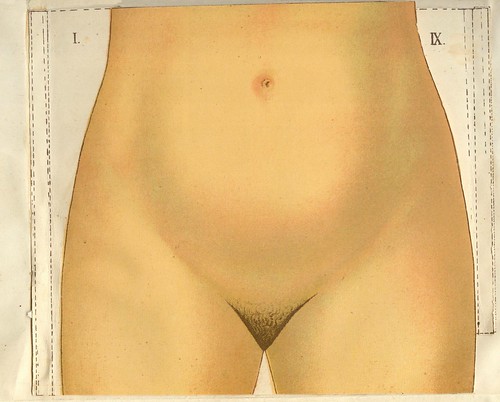



The
Getty Villa in Malibu, California has an interesting show up called "The Color of Life: Polychromy in Sculpture from Antiquity to the Present." The exhibition showcases the many ways artists have used color in figural sculpture for centuries, and, to my excitement, includes an actual Anatomical Venus from the famed
La Specola collection in Florence!
Anatomical Venuses are life-sized wax anatomical models of idealized women, extremely realistic in appearance and often adorned with real hair and ornamental jewelry. These figures consist of removable parts that can be "dissected" to demonstrate anatomy-- a breast plate is lifted to reveal the inner workings of the mysterious female body, often with a fetus to be found nestling in the womb (see before and after above). This was a way to share anatomical discovery with a larger audience without the need for an actual human dissection.
Anatomical Venuses are probably the most historically popular form of anatomical models; in the 19th-Century, they were the centerpiece of museums and itinerant shows of all kinds, and possessed great power to draw crowds. The 18th-Century Florentine Venuses are the best remembered today, in no small part due to Taschen's
Encyclopaedia Anatomica,
and are considered, by some, to be the finest examples of Anatomical Venuses known to exist.
This Anatomical Venus featured in the Getty show, completed in 1782 by Clemente Susini and his workshop, is truly a masterwork of the genre, and outshines the many copies held by medical museums throughout Europe who, impressed by the veracity and workmanship of the Florentine Venuses, commissioned their own from Susini's workshop. For example, the core of the collection of the Viennese
Josephinum Museum consists of 1192 models commissioned by Emperor Joseph from the Susini workshop in 1784 for the training of his military doctors. As a body of work they are interesting, but somehow the models in this collection pale in comparison to the La Specola models. The workmanship is a bit shoddier, the visages a bit less alluring.
The Anatomical Venus exhibited in the Getty exhibition is one of the finest, and almost never leaves her home in Florence--she has only been transported twice in her long history, and even has a specially-built traveling case to protect her delicate wax body. This means that, sadly, you will not see her in her original setting--an elegant
rosewood and Venetian glass case-- but the relative accessibility of the piece (i.e. in the United States) should make up for this lack.
It is really great to see anatomical models being seriously approached as artwork in an exhibition of this sort; I consider it a bold move on the part of the curators, and cannot help wondering what strings the curators had to pull in order to acquire one of these rare and fragile Venuses on loan. It is also nice to see that, in reviews of the show, the Venus seems to be a real standout. This supports my belief that, if more people knew of these Venuses and other anatomical models, they would be seen as intriguing artworks and cultural documents, worthy of a greater amount of study as well as inclusion in the medical art canon.
From the UCLA paper
The Daily Bruin:The two most impressive pieces of the whole exhibition, which may please even marble lovers, both shock and fascinate at the same time. One of them is an 18th-century wax model of a nude life-size woman called the “Anatomical Venus,” which shows the multicolored exterior and interior of a female body with an almost uncanny precision.
And from the LA Times
review of the show:
The strangest, without a doubt, is an 18th century wax figure known as the "Anatomical Venus": a comely young woman, life-sized and nude, lying prostrate on a pink silk cushion in what looks to be a state of sensual rapture, her torso flayed and all her glistening organs -- including a womb containing a tiny fetus -- revealed. Her long brown hair is real, her eyes are open and unfocused, and the cloth of her pillow is crumpled -- she might as well be writhing. The product of one sculptor's clearly intimate experience with cadavers, she suggests an Enlightenment-era St. Teresa ravished by communion with the invisible forces of science.
To learn more about the show, which runs until June 23 of this year, visit the
exhibition website, complete with gallery slideshow. Better yet, visit the show in person if you are able. This might be your only chance EVER to see an Anatomical Venus of this quality without traveling to Florence. To see more images of Anatomical Venuses and other anatomical models, see the
Anatomical Theatre Gallery. To learn more about medical models, see Susan Lamb's
An Analysis of Anatomy Models and A. W. Bates' abstract for
Anatomical Venuses: The Aesthetics of Anatomical Modeling in 18th- and 19th-Century Europe. You can also see the Venus in all states of metaphorical undress in Taschen's
Encyclopaedia Anatomica.
Thanks to the Getty for supplying the above images and answering my barrage of questions. Photographs of the Anatomical Venus by Saulo Bambi, Museo di Storia Naturale "La Specola"; Florence, Italy
And if any Morbid Anatomy readers are in the Los Angeles area and could take a photo of the model in context of the show and
send me a copy, I'd very much appreciate it.

















































